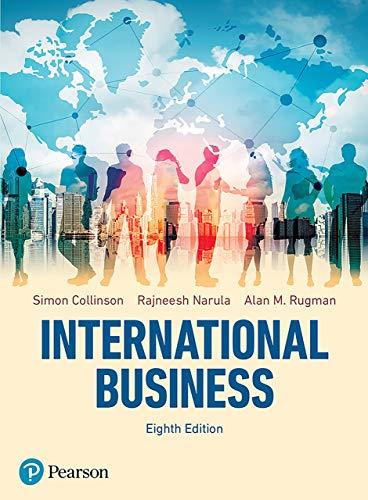Among industrialised countries, the US market for pharmaceuticals is the least regulated and thus the largest in
Question:
Among industrialised countries, the US market for pharmaceuticals is the least regulated and thus the largest in the world. Not surprisingly, European companies like AstraZeneca, Aventis and GlaxoSmithKline (GSK) depend more heavily on the North American market for their revenues than on Europe as a whole. Europe is a more fragmented market, with individual distribution systems and more layers of regulation, and governments are in the habit of imposing price controls. As a result, Europeans spend 60 per cent less per capita on pharmaceuticals than their American counterparts. With $39.18 billion in revenues and 95,490 employees in 2018, GSK is one of the largest pharmaceutical companies in the world. Although headquartered in the United Kingdom, it is not surprising that GSK manages its operations in the United States. Some 39 per cent of its sales originate in this host nation, a fact that is consistent with world trends – the United States accounts for 40 per cent of the world market for pharmaceuticals, while the European market accounts for 26 per cent. GSK derives 35 per cent of its sales from the rest of the world. Approximately 30 years ago, British Glaxo was a small company in the dried milk, antibiotics, respiratory drugs and nutritional businesses. The discovery of Zantac, a drug to treat stomach ulcers, catapulted the company into the mainstream pharmaceutical market and financed its expansion into the US market. As the patent for Zantac was about to expire, Glaxo found itself in a sticky situation. Up to that point the company had relied on internal R&D, but this had failed to develop the R&D capabilities for sustainable long-term growth. In 1995, the company merged with Wellcome, a company known for its strength in R&D and its lack of marketing capabilities. The merger was successful in that the new company now had a stream of new drugs that could be marketed using Glaxo’s expertise. By 2000, Glaxo Wellcome was disappointing investors once again. Drug prospects, at least in the short term, were below the industry average and expected revenues from some of its products never materialised. Yet the merger with SmithKline Beecham was not driven by the same urgency as the previous merger. Both companies had a reasonably stable pipeline and a balanced portfolio of drugs. According to Sir Richard Sykes, then Chairman of Glaxo Wellcome, the deciphering of the human genome would transform the industry and only large companies that could afford to invest in working with this new information would succeed. Together, these two companies are immune to the near-death experience of losing a major blockbuster drug. No one drug accounts for more than 12 per cent of the company’s revenues. GSK operates in two product-based industry segments: (1) pharmaceuticals, which include prescription drugs and vaccines; and (2) consumer healthcare, which includes over-the counter (OTC) medicines, oral care and nutritional healthcare. Prescription drugs are sold mainly to wholesalers, which dispense them to the public through pharmacies. Consumer healthcare products are sold through pharmacies, whole-salers or directly to retail outlets. In 2009, GSK acquired a series of R&D-intensive firms, including Stiefel Laboratories, Pfizer’s HIV business, the Algerian pharmaceutical, manufacturing and distribution group, and NovaMin Technology. The periodic acquisition and integration of new R&D pipelines and expertise helps the firm refresh its new product development process. The first step in the development of a drug is R&D. In 2018, GSK spent around $5 billion on R&D and has 11,000 of employees working in research in 20 R&D sites around the world. Once GSK has developed a new drug, it must obtain government approval in every individual nation where the company markets the product, a process that can differ significantly in each jurisdiction. Production and marketing are the next steps for a new drug. GSK’s supply chain is divided into a primary chain and a secondary chain. The primary chain manufactures active ingredients for its products and ships them to the secondary chain, which manufactures the end product. There are 13 primary supply-chain sites based in Australia, India, Ireland, Singapore, the United States and the UK. In Europe, there are 17 secondary supply-chain sites, while North America houses an additional six sites. The rest of the world has 32 secondary sites in 19 countries (5 in the Middle East and Africa, 22 in Asia-Pacific, and 5 in Latin America). Different price regulations at a national level have created some market abnormalities in each region. For instance, Canadian web-based pharmacies have sprung up to service US consumers seeking cheaper alternatives. GSK sent a heavily worded letter to Canadian wholesalers that were selling to these pharmacies and threatened to stop supplies. In Spain, GSK developed a two-price system: one lower price for products to be sold in Spain and a higher price for those to be exported to other EU member countries. The EU found this practice illegal.
Step by Step Answer:

International Business
ISBN: 9781292274157
8th Edition
Authors: Simon Collinson, Rajneesh Narula, Alan M. Rugman





